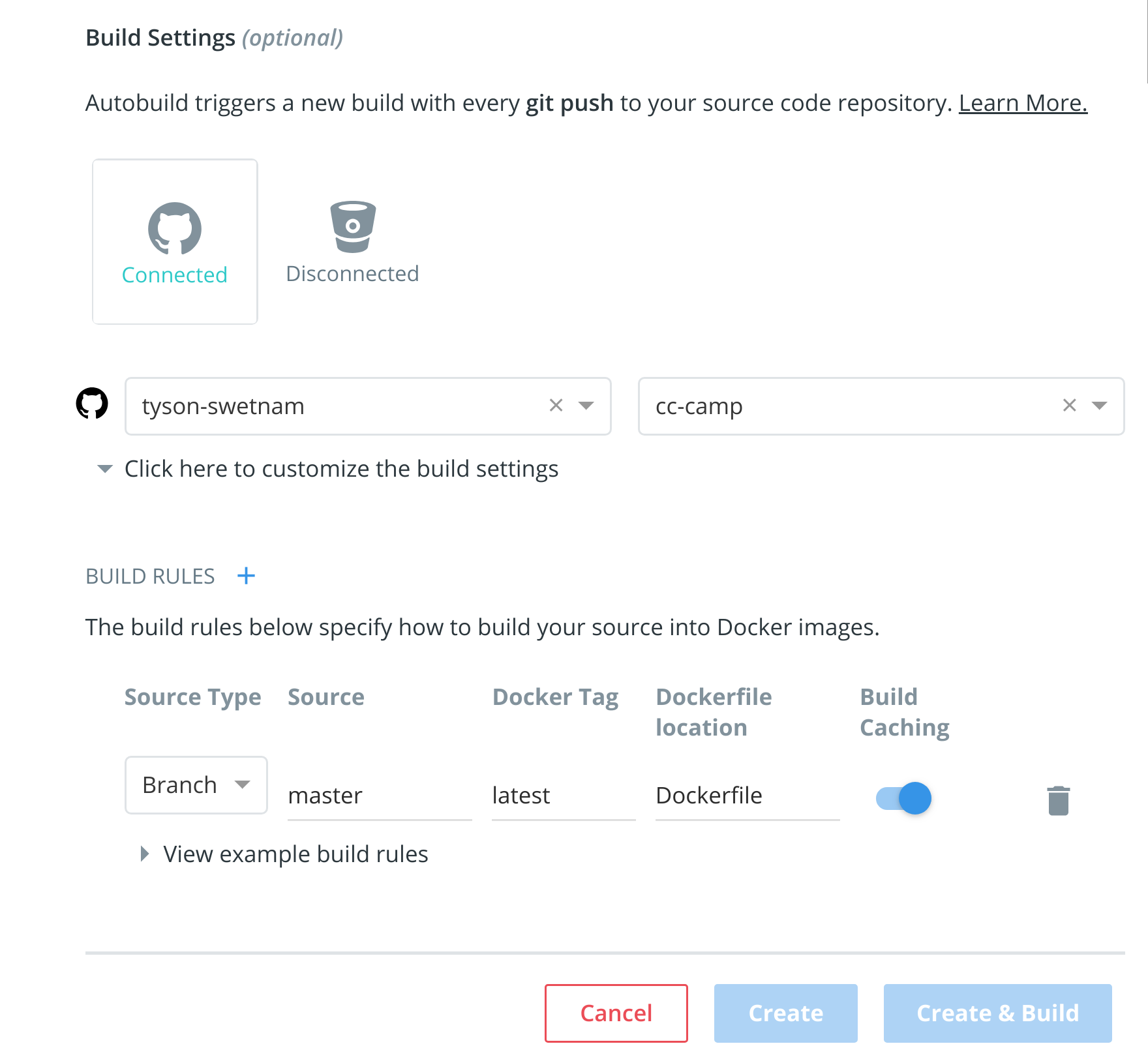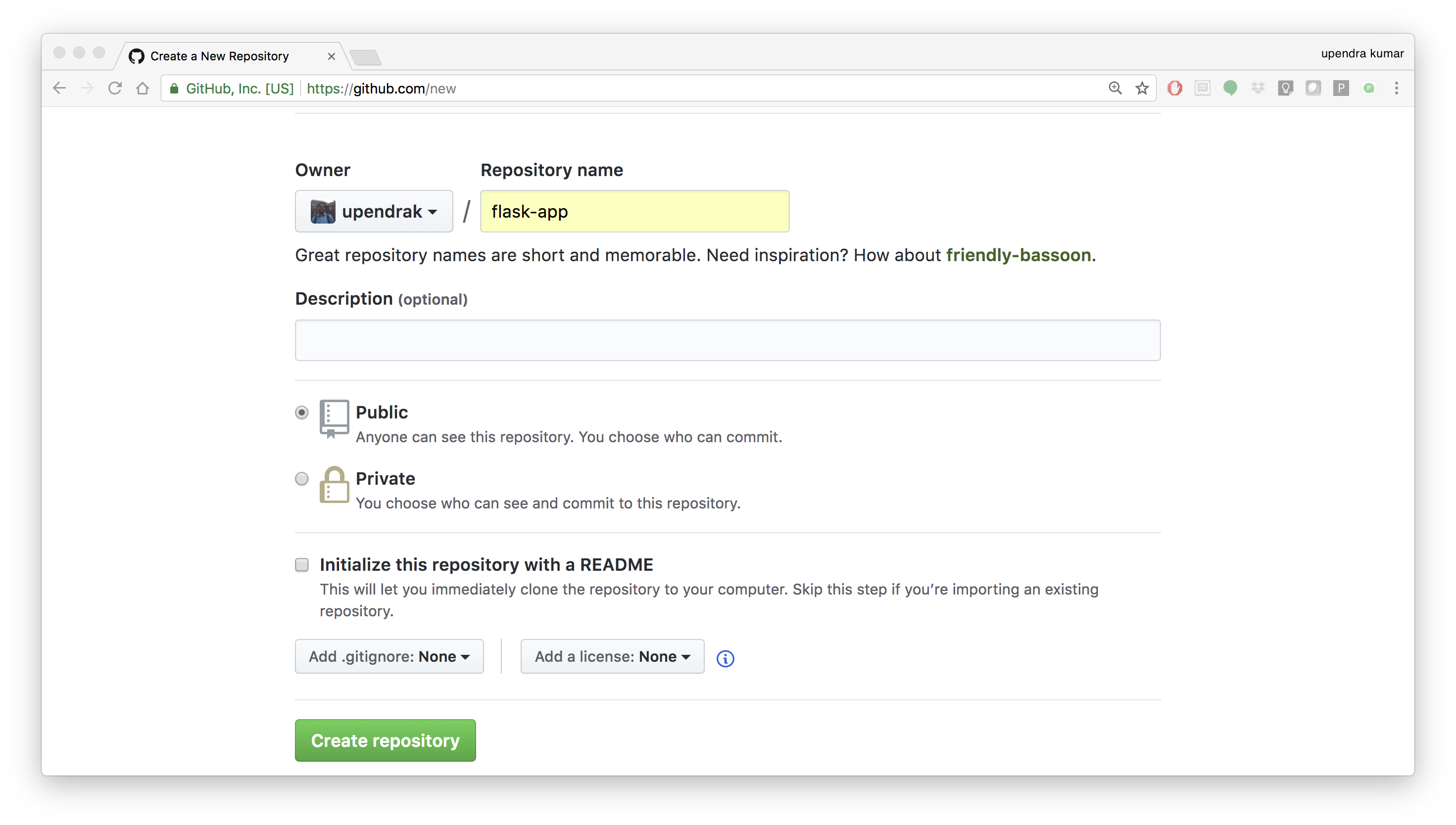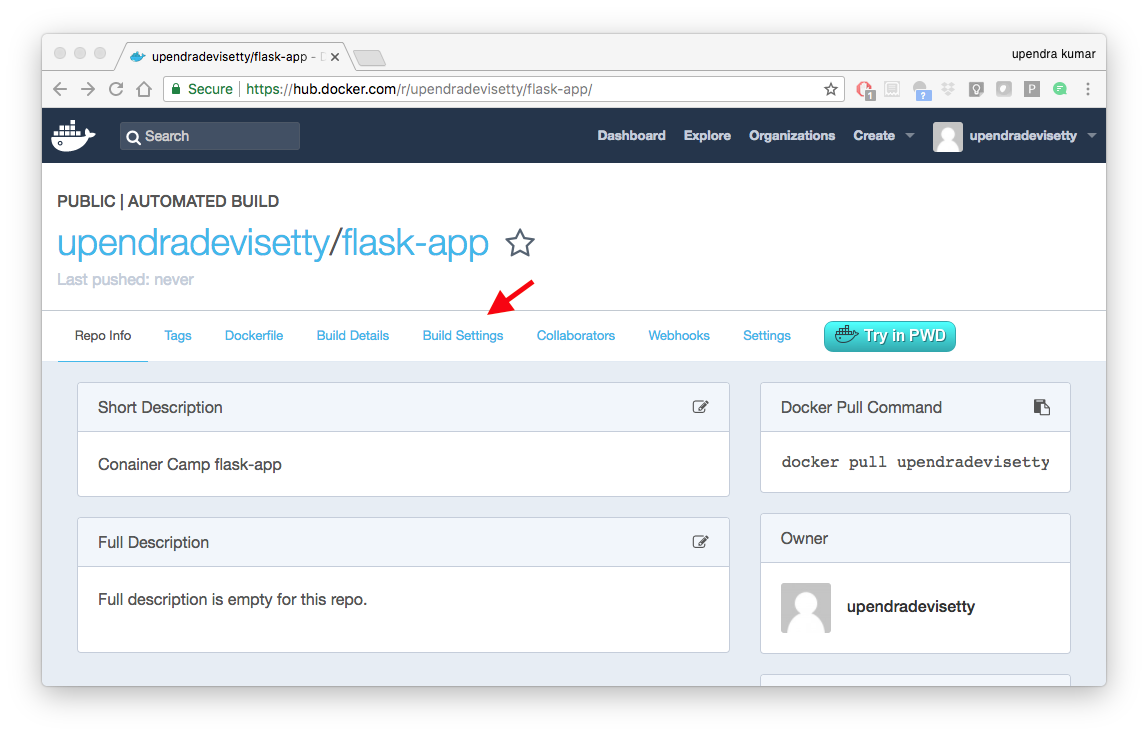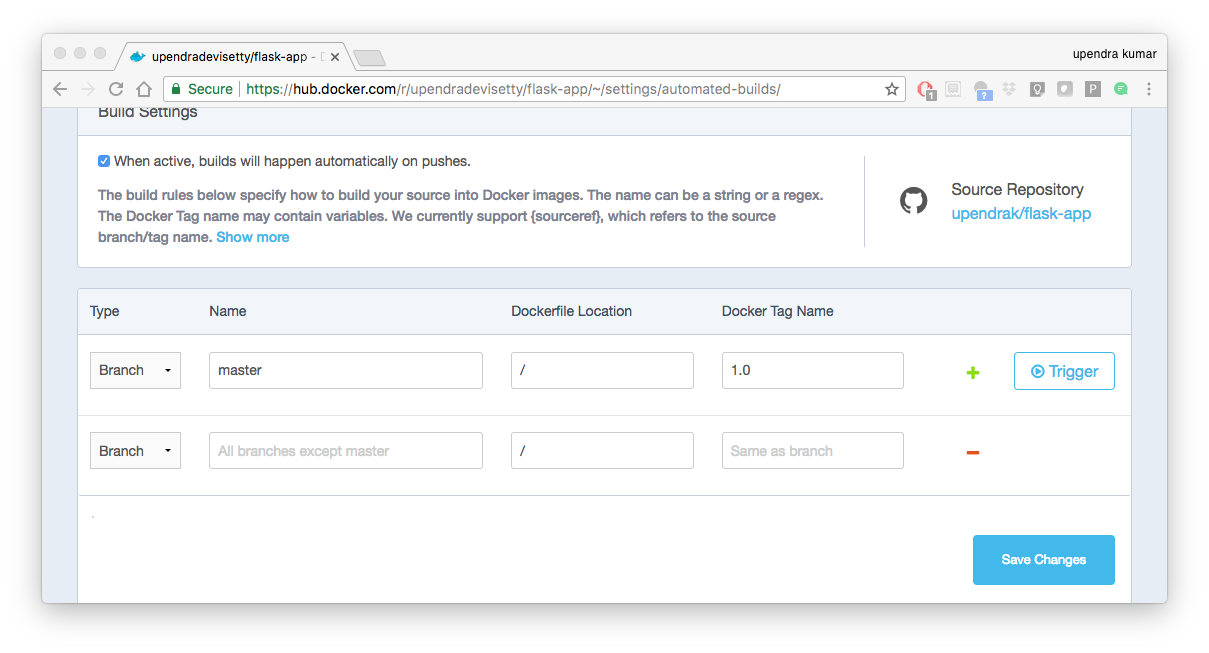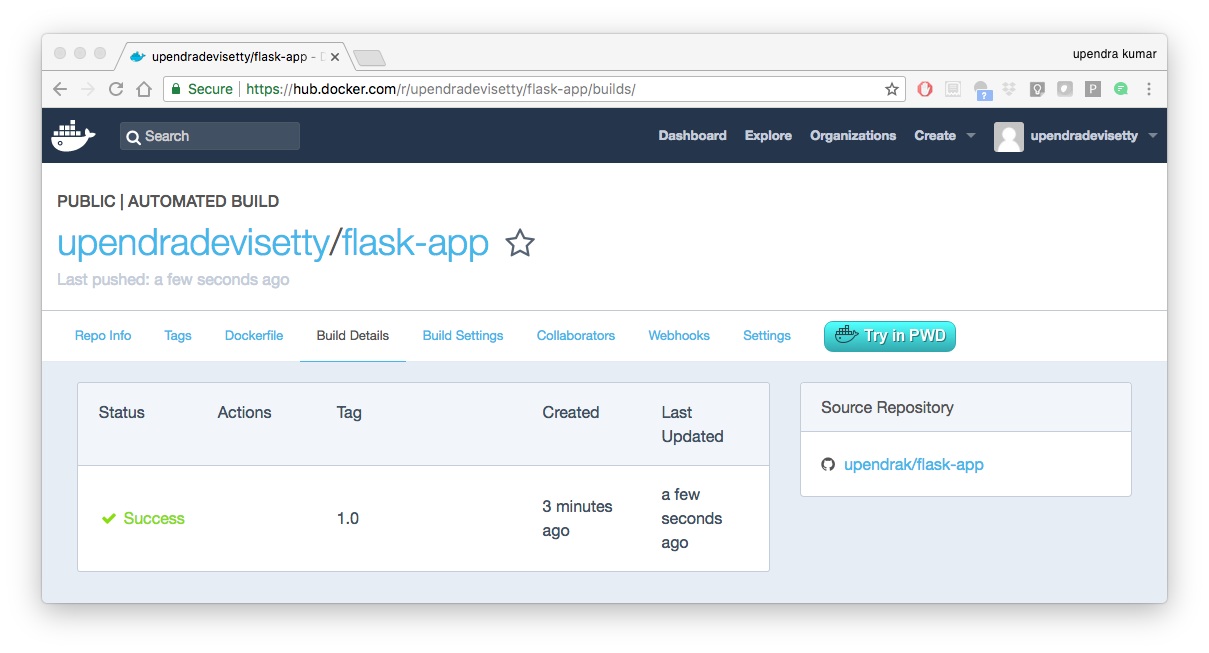Advanced Docker¶
Now that we are relatively comfortable with Docker, lets look at some advanced Docker topics, such as:
- Push a Docker image to the Docker Hub Registry
- Modifying a Dockerfile and creating a new container
- Establish a Docker Hub autobuild on GitHub with CI/CD
1.0 The Dockerfile¶
Note
This is one of the official Docker images provided by the Jupyter Project for you to build your own data science notebooks on:
Create a file called Dockerfile, and add content to it as described below, e.g.
$ nano Dockerfile
Important
Dockerfile needs to be capitalized.
Contents of our Dockerfile:
# base image
FROM jupyter/scipy-notebook:latest
# reset user to root for installing additional packages
USER root
# Install a few dependencies for iCommands, text editing, and monitoring instances
RUN apt-get update && apt-get install -y \
apt-transport-https \
gcc \
gnupg \
htop \
less \
libfuse2 \
libpq-dev \
libssl1.0 \
lsb \
nano \
nodejs \
python-requests \
software-properties-common \
vim
# Install iCommands
RUN wget https://files.renci.org/pub/irods/releases/4.1.12/ubuntu14/irods-icommands-4.1.12-ubuntu14-x86_64.deb && \
dpkg -i irods-icommands-4.1.12-ubuntu14-x86_64.deb && \
rm irods-icommands-4.1.12-ubuntu14-x86_64.deb
# reset container user to jovyan
USER jovyan
# set the work directory
WORKDIR /home/jovyan
# copy configuration json and entry file into the container
COPY jupyter_notebook_config.json /opt/conda/etc/jupyter/jupyter_notebook_config.json
COPY entry.sh /bin
# expose the public port we want to run on
EXPOSE 8888
# directory will be populated by iCommands when entry.sh is run
RUN mkdir -p /home/jovyan/.irods
ENTRYPOINT ["bash", "/bin/entry.sh"]
Note
We use a code line escape character \ to allow single line scripts to be written on multiple lines in the Dockerfile.
We also use the double characters && which essentially mean “if true, then do this” while executing the code. The && can come at the beginning of a line or the end when used with \
Now let’s talk about what each of those lines in the Dockerfile mean.
1. We’ll start by specifying our base image, using the FROM statement
FROM jupyter/scipy-notebook:latest
2. Copy existing files into the new image by using the COPY statement
COPY entry.sh /bin
COPY jupyter_notebook_config.json /opt/conda/etc/jupyter/jupyter_notebook_config.json
Before we forget, create a new file called entry.sh – use your preferred text editor to create the file, e.g. nano entry.sh and put it in the same directory as Dockerfile
#!/bin/bash
echo '{"irods_host": "data.cyverse.org", "irods_port": 1247, "irods_user_name": "$IPLANT_USER", "irods_zone_name": "iplant"}' | envsubst > $HOME/.irods/irods_environment.json
exec jupyter lab --no-browser
The entry.sh file creates an iRODS environment .json which has CyVerse Data Store configurations pre-written. It also tells Docker to start Jupter Lab and to not pop open a browser tab when doing so.
We also create a jupyter_notebook_config.json which will help launch the notebook without a token
{
"NotebookApp": {
"allow_origin" : "*",
"token":"",
"password":"",
"nbserver_extensions": {
"jupyterlab": true
}
}
}
3. Specify the port number which needs to be exposed. Since Jupyter runs on 8888 that’s what we’ll expose.
EXPOSE 8888
Note
What about CMD?
Notice that unlike some other Dockerfile this one does not end with a CMD command statement. This is on purpose.
Remember: The primary purpose of CMD is to tell the container which command it should run by default when it is started.
Can you guess what will happen if we don’t specify an ENTRYPOINT or CMD?
4. Setting a new entrypoint
When this container is run, it will now use a different default ENTRYPOINT than the original container from jupyter/scipy-notebook:latest
ENTRYPOINT ["bash", "/bin/entry.sh"]
This entrypoint runs the shell script entry.sh which we just copied into the image
A quick summary of the few basic commands we used in our Dockerfiles.
- FROM starts the Dockerfile. It is a requirement that the Dockerfile must start with the FROM command. Images are created in layers, which means you can use another image as the base image for your own. The FROM command defines your base layer. As arguments, it takes the name of the image. Optionally, you can add the Dockerhub username of the maintainer and image version, in the format username/imagename:version.
- RUN is used to build up the Image you’re creating. For each RUN command, Docker will run the command then create a new layer of the image. This way you can roll back your image to previous states easily. The syntax for a RUN instruction is to place the full text of the shell command after the RUN (e.g., RUN mkdir /user/local/foo). This will automatically run in a /bin/sh shell. You can define a different shell like this: RUN /bin/bash -c ‘mkdir /user/local/foo’
- COPY copies local files into the container.
- CMD defines the commands that will run on the Image at start-up. Unlike a RUN, this does not create a new layer for the Image, but simply runs the command. There can only be one CMD per a Dockerfile/Image. If you need to run multiple commands, the best way to do that is to have the CMD run a script. CMD requires that you tell it where to run the command, unlike RUN. So example CMD commands would be:
- EXPOSE creates a hint for users of an image which ports provide services. It is included in the information which can be retrieved via
$ docker inspect <container-id>.
Note
The EXPOSE command does not actually make any ports accessible to the host! Instead, this requires publishing ports by means of the -p flag when using docker run.
2.0 Docker Build¶
Note
Remember to replace <DOCKERHUB_USERNAME> with your username. This username should be the same one you created when registering on Docker hub.
DOCKERHUB_USERNAME=<YOUR_DOCKERHUB_USERNAME>
For example this is how I assign my dockerhub username
DOCKERHUB_USERNAME=tswetnam
Now build the image using the following command:
$ docker build -t $DOCKERHUB_USERNAME/jupyterlab-scipy:cyverse .
Sending build context to Docker daemon 3.072kB
Step 1/3 : FROM jupyter/minimal-notebook
---> 36c8dd0e1d8f
Step 2/3 : COPY model.py /home/jovyan/work/
---> b61aefd7a735
Step 3/3 : EXPOSE 8888
---> Running in 519dcabe4eb3
Removing intermediate container 519dcabe4eb3
---> 7983fe164dc6
Successfully built 7983fe164dc6
Successfully tagged tswetnam/jupyterlab-scipy:cyverse
If everything went well, your image should be ready! Run docker images and see if your image $DOCKERHUB_USERNAME/jupyterlab-scipy:cyverse shows.
2.1 Test the image¶
When Docker can successfully build your Dockerfile, test it by starting a new container from your new image using the docker run command. Don’t forget to include the port forwarding options you learned about before.
$ docker run --rm -it -p 8888:8888 $DOCKERHUB_USERNAME/jupyterlab-scipy:cyverse
You should see something like this:
Executing the command: jupyter notebook
[I 07:21:25.396 NotebookApp] Writing notebook server cookie secret to /home/jovyan/.local/share/jupyter/runtime/notebook_cookie_secret
[I 07:21:25.609 NotebookApp] JupyterLab extension loaded from /opt/conda/lib/python3.7/site-packages/jupyterlab
[I 07:21:25.609 NotebookApp] JupyterLab application directory is /opt/conda/share/jupyter/lab
[I 07:21:25.611 NotebookApp] Serving notebooks from local directory: /home/jovyan
[I 07:21:25.611 NotebookApp] The Jupyter Notebook is running at:
[I 07:21:25.611 NotebookApp] http://(29a022bb5807 or 127.0.0.1):8888/?token=copy-your-own-token-not-this-one
[I 07:21:25.611 NotebookApp] Use Control-C to stop this server and shut down all kernels (twice to skip confirmation).
[C 07:21:25.612 NotebookApp]
Copy/paste this URL into your browser when you connect for the first time,
to login with a token:
http://(29a022bb5807 or 127.0.0.1):8888/?token=copy-your-own-token-not-this-one
Head over to http://localhost:8888 and your Jupyter notebook server should be running.
Note: Copy the token from your own docker run output and paste it into the ‘Password or token’ input box.
Note
If you want to learn more about Dockerfiles, check out Best practices for writing Dockerfiles.
2.2 Tagging images¶
The notation for associating a local image with a repository on a registry is username/repository:tag. The tag is optional, but recommended, since it is the mechanism that registries use to give Docker images a version. Give the repository and tag meaningful names for the context, such as get-started:part2. This will put the image in the get-started repository and tag it as part2.
Note
By default the docker image gets a latest tag if you don’t provide one. Thought convenient, it is not recommended for reproducibility purposes.
Now, put it all together to tag the image. Run docker tag image with your username, repository, and tag names so that the image will upload to your desired destination. For our docker image since we already have our Dockerhub username we will just add tag which in this case is 1.0
$ docker tag jupyterlab-scipy:cyverse $DOCKERHUB_USERNAME/jupyterlab-scipy:cyverse
3.0 Publishing your image¶
3.1 Log into the Docker Hub Registry¶
Note
If you don’t have an account, sign up for one at Docker Cloud or Docker Hub. Make note of your username – it may or may not be the same as your email, GitHub, or CyVerse username. There are several advantages to registering with registries like DockerHub which we will see later on in the session.
If you want to authenticate to a different Registry, type the name of the registry after login:
$ docker login <registry-name>
Authenticating with existing credentials...
WARNING! Your password will be stored unencrypted in /home/tswetnam/.docker/config.json.
Configure a credential helper to remove this warning. See
https://docs.docker.com/engine/reference/commandline/login/#credentials-store
Login Succeeded
If it is your first time logging in you will be queried for your username and password.
Login with your Docker ID to push and pull images from Docker Hub or private registry.
If you don’t have a Docker ID, head over to https://hub.docker.com to create one. Upload your tagged image to the Dockerhub repository
$ docker push $DOCKERHUB_USERNAME/jupyterlab-scipy:cyverse
Once complete, the results of this upload are publicly available. If you log in to Docker Hub, you will see the new image there, with its pull command.
Congrats! You just made your first Docker image and shared it with the world!
3.2 Pull and run the image from the remote repository¶
Now run the following command to run the docker image from Dockerhub
$ docker run -p 8888:8888 --name notebooktest $DOCKERHUB_USERNAME/jupyterlab-scipy:cyverse
Note
You don’t have to run docker pull since if the image isn’t available locally on the machine, Docker will pull it from the repository.
Head over to http://<vm-address>:8888 and your app should be live.
3.3 Private repositories¶
In an earlier part, we had looked at the Docker Hub, which is a public registry that is hosted by Docker. While the Dockerhub plays an important role in giving public visibility to your Docker images and for you to utilize quality Docker images put up by others, there is a clear need to setup your own private registry too for your team/organization. For example, CyVerse has it own private registry which will be used to push the Docker images.
3.4 Pull down the Registry Image¶
You might have guessed by now that the registry must be available as a Docker image from the Docker Hub and it should be as simple as pulling the image down and running that. You are correct!
A Dockerhub search on the keyword registry brings up the following image as the top result:
Run a container from registry Dockerhub image
$ docker run -d -p 5000:5000 --name registry registry:2
Run docker ps --latest to check the recent container from this Docker image
$ docker ps --latest
CONTAINER ID IMAGE COMMAND CREATED STATUS PORTS NAMES
6e44a0459373 registry:2 "/entrypoint.sh /e..." 11 seconds ago Up 10 seconds 0.0.0.0:5000->5000/tcp registry
Tag the image that you want to push¶
Next step is to tag your image under the registry namespace and push it there
$ REGISTRY=localhost:5000
$ docker tag $DOCKERHUB_USERNAME/jupyterlab-scipy:cyverse $REGISTRY/$(whoami)/mynotebook:1.0
Publish the image into the local registry¶
Finally push the image to the local registry
$ docker push $REGISTRY/$(whoami)/mynotebook:1.0
The push refers to a repository [localhost:5000/julianp/mynotebook]
64436820c85c: Pushed
831cff83ec9e: Pushed
c3497b2669a8: Pushed
1c5b16094682: Pushed
c52044a91867: Pushed
60ab55d3379d: Pushed
1.0: digest: sha256:5095dea8b2cf308c5866ef646a0e84d494a00ff0e9b2c8e8313a176424a230ce size: 1572
Pull and run the image from the local repository¶
You can also pull the image from the local repository similar to how you pull it from Dockerhub and run a container from it
$ docker run -P --name=mynotebooklocal $REGISTRY/$(whoami)/jupyterlab-scipy:cyverse
4.0 Automated Docker image building from GitHub¶
An automated build is a Docker image build that is triggered by a code change in a GitHub or Bitbucket repository. By linking a remote code repository to a Dockerhub automated build repository, you can build a new Docker image every time a code change is pushed to your code repository.
A build context is a Dockerfile and any files at a specific location. For an automated build, the build context is a repository containing a Dockerfile.
Automated Builds have several advantages:
- Images built in this way are built exactly as specified.
- The Dockerfile is available to anyone with access to your Docker Hub repository.
- Your repository is kept up-to-date with code changes automatically.
- Automated Builds are supported for both public and private repositories on both GitHub and Bitbucket.
4.1 Prerequisites¶
To use automated builds, you first must have an account on Docker Hub and on the hosted repository provider (GitHub or Bitbucket). While Docker Hub supports linking both GitHub and Bitbucket repositories, here we will use a GitHub repository. If you don’t already have one, make sure you have a GitHub account. A basic account is free
Note
- If you have previously linked your Github or Bitbucket account, you must have chosen the Public and Private connection type. To view your current connection settings, log in to Docker Hub and choose Profile > Settings > Linked Accounts & Services.
- Building Windows containers is not supported.
4.2 Link your Docker Hub account to GitHub¶
- Log into Docker Hub.
- Click “Create Repository+”
- Click the Build Settings and select
GitHub.
The system prompts you to choose between Public and Private and Limited Access. The Public and Private connection type is required if you want to use the Automated Builds.
- Press
Selectunder Public and Private connection type. If you are not logged into GitHub, the system prompts you to enter GitHub credentials before prompting you to grant access. After you grant access to your code repository, the system returns you to Docker Hub and the link is complete.
After you grant access to your code repository, the system returns you to Docker Hub and the link is complete. For example, github linked hosted repository looks like this:
4.3 Automated Container Builds¶
Automated build repositories rely on the integration with a version control system (GitHub or Gitlab) where your Dockerfile is kept.
Let’s create an automatic build for our container using the instructions below:
- Initialize git repository for the mynotebook directory you created for your
Dockerfile
$ git init
Initialized empty Git repository in /home/julianp/mynotebook/.git/
$ git status
On branch master
Initial commit
Untracked files:
(use "git add <file>..." to include in what will be committed)
Dockerfile
model.py
nothing added to commit but untracked files present (use "git add" to track)
$ git add * && git commit -m "Add files and folders"
[master (root-commit) a4f732a] Add files and folders
2 files changed, 10 insertions(+)
create mode 100644 Dockerfile
create mode 100644 model.py
- Create a new repository on github by navigating to this URL - https://github.com/new
Note
Don’t initialize the repository with a README and don’t add a license.
- Push the repository to github
$ git remote add origin https://github.com/<your-github-username>/mynotebook.git
$ git push -u origin master
Counting objects: 7, done.
Delta compression using up to 8 threads.
Compressing objects: 100% (5/5), done.
Writing objects: 100% (7/7), 1.44 KiB | 0 bytes/s, done.
Total 7 (delta 0), reused 0 (delta 0)
To https://github.com/<your-github-username>/mynotebook.git
* [new branch] master -> master
Branch master set up to track remote branch master from origin.
- Select
Create>Create Automated Buildfrom Docker Hub.
- The system prompts you with a list of User/Organizations and code repositories.
- For now select your GitHub account from the User/Organizations list on the left. The list of repositories change.
- Pick the project to build. In this case
mynotebook. Type in “Jupyter Test” in the Short Description box. - If you have a long list of repos, use the filter box above the list to restrict the list. After you select the project, the system displays the Create Automated Build dialog.
Note
The dialog assumes some defaults which you can customize. By default, Docker builds images for each branch in your repository. It assumes the Dockerfile lives at the root of your source. When it builds an image, Docker tags it with the branch name.
- Customize the automated build by pressing the
Click here to customizebehavior link.
Specify which code branches or tags to build from. You can build by a code branch or by an image tag. You can enter a specific value or use a regex to select multiple values. To see examples of regex, press the Show More link on the right of the page.
- Enter the
master(default) for the name of the branch. - Leave the Dockerfile location as is.
- Recall the file is in the root of your code repository.
- Specify
1.0for the Tag Name.
- Click
Create.
Important
During the build process, Docker copies the contents of your Dockerfile to Docker Hub. The Docker community (for public repositories) or approved team members/orgs (for private repositories) can then view the Dockerfile on your repository page.
The build process looks for a README.md in the same directory as your Dockerfile. If you have a README.md file in your repository, it is used in the repository as the full description. If you change the full description after a build, it’s overwritten the next time the Automated Build runs. To make changes, modify the README.md in your Git repository.
Warning
You can only trigger one build at a time and no more than one every five minutes. If you already have a build pending, or if you recently submitted a build request, Docker ignores new requests.
It can take a few minutes for your automated build job to be created. When the system is finished, it places you in the detail page for your Automated Build repository.
- Manually Trigger a Build
Before you trigger an automated build by pushing to your GitHub mynotebook repo, you’ll trigger a manual build. Triggering a manual build ensures everything is working correctly.
From your automated build page choose Build Settings
Press Trigger button and finally click Save Changes.
Note
Docker builds everything listed whenever a push is made to the code repository. If you specify a particular branch or tag, you can manually build that image by pressing the Trigger. If you use a regular expression syntax (regex) to define your build branch or tag, Docker does not give you the option to manually build.
- Review the build results
The Build Details page shows a log of your build systems:
Navigate to the Build Details page.
Wait until your image build is done.
You may have to manually refresh the page and your build may take several minutes to complete.
Exercise 1 (5-10 mins): Updating and automated building¶
git add,commitandpushto your GitHub or Gitlab repo- Trigger automatic build with a new tag (2.0) on Docker Hub
- Pull your Docker image from Docker Hub to a new location.
- Run the instance to make sure it works
5.0 Volumes Continued¶
When you run a container, you can bring a directory from the host system into the container, and give it a new name and location using the -v or --volume flag.
$ mkdir -p ~/local-data-folder
$ echo "some data" >> ~/local-data-folder/data.txt
$ docker run -v ${HOME}/local-data-folder:/data $YOUR_DOCKERHUB_USERNAME/mynotebook:latest cat /data/data.txt
In the example above, you can mount a folder from your localhost, in your home user directory into the container as a new directory named /data.
Unlike a bind mount, you can create and manage volumes outside the scope of any container.
A given volume can be mounted into multiple containers simultaneously. When no running container is using a volume, the volume is still available to Docker and is not removed automatically. You can remove unused volumes using docker volume prune command.
When you create a Docker volume, it is stored within a directory on the Docker Linux host (/var/lib/docker/
Note
File location on Mac OS X is a bit different: https://timonweb.com/posts/getting-path-and-accessing-persistent-volumes-in-docker-for-mac/
Let’s create a volume
$ docker volume create my-vol
List volumes:
$ docker volume ls
local my-vol
Inspect a volume by looking at the Mount section in the docker volume inspect
$ docker volume inspect my-vol
[
{
"Driver": "local",
"Labels": {},
"Mountpoint": "/var/lib/docker/volumes/my-vol/_data",
"Name": "my-vol",
"Options": {},
"Scope": "local"
}
]
Remove a volume
$ docker volume rm my-vol
$ docker volume ls
This example starts an alpine container and populates the new volume output-vol with the some output created by the container.
docker volume create output-vol
docker run --name=data-app --mount source=output-vol,target=/data alpine sh -c 'env >> /data/container-env.txt'
Use docker inspect output-vol to see where the volume data lives on your host, and then use cat to confirm that it contains the output created by the container.
docker volume inspect output-vol
sudo cat /var/lib/docker/volumes/output-vol/_data/container-env.txt
You should see something like:
After running either of these examples, run the following commands to clean up the container and volume.
docker rm data-app
docker volume rm output-vol
5.3 Bind mounts¶
Bind mounts: When you use a bind mount, a file or directory on the host machine is mounted into a container.
Tip
If you are developing new Docker applications, consider using named volumes instead. You can’t use Docker CLI commands to directly manage bind mounts.
Warning
One side effect of using bind mounts, for better or for worse, is that you can change the host filesystem via processes running in a container, including creating, modifying, or deleting important system files or directories. This is a powerful ability which can have security implications, including impacting non-Docker processes on the host system.
If you use --mount to bind-mount a file or directory that does not yet exist on the Docker host, Docker does not automatically create it for you, but generates an error.
Start a container with a bind mount¶
Create a bind-data directory in your home directory.
cd ~
mkdir -p ~/bind-data
Run a container, mounting this directory inside the container, and the container should create some data in there.
docker run --mount type=bind,source="$(pwd)"/bind-data,target=/data alpine sh -c 'env >> /data/container-env.txt'
Check that the output looks right.
cat ~/bind-data/container-env.txt
Use a read-only bind mount¶
For some development applications, the container needs to write into the bind mount, so changes are propagated back to the Docker host. At other times, the container only needs read access.
This example modifies the one above but mounts the directory as a read-only bind mount, by adding ro to the (empty by default) list of options, after the mount point within the container. Where multiple options are present, separate them by commas.
docker run --mount type=bind,source="$(pwd)"/bind-data,target=/data,readonly alpine sh -c 'ls -al /data/ && env >> /data/container-env.txt'
You should see an error message about not being able to write to a read-only file system.
sh: can't create /data/container-env.txt: Read-only file system
6.0 Docker Compose for multi-container apps¶
Docker Compose is a tool for defining and running multi-container Docker applications. It requires you to have a docker-compose.yml file.
Note
Docker for Mac and Docker Toolbox already include Compose along with other Docker apps, so Mac users do not need to install Compose separately. Docker for Windows and Docker Toolbox already include Compose along with other Docker apps, so most Windows users do not need to install Compose separately.
For Linux users
sudo curl -L https://github.com/docker/compose/releases/download/1.25.4/docker-compose-`uname -s`-`uname -m` -o /usr/local/bin/docker-compose
sudo chmod +x /usr/local/bin/docker-compose
Main advantages of Docker compose include:
- Your applications can be defined in a YAML file where all the same options required in
docker runare now defined (reproducibility). - It allows you to manage your application(s) as a single entity rather than dealing with starting individual containers (simplicity).
Let’s now create a Docker Compose .yml that calls Jupyter Lab SciPy
- Copy or create the
jupyter_composedirectory
$ mkdir jupyter_compose && cd jupyter_compose
We will also create data/ and notebooks/ folders to stage our future data and notebook work
$ mkdir jupyter_compose/data
$ mkdir jupyter_compose/notebooks
- Copy or create a
entry.shand ajupyter_notebook_config.jsonin thejupyter_compose/directory
entry.sh creates an iRODS environment JSON with the user’s name and CyVerse (iPlant) zone.
#!/bin/bash
echo '{"irods_host": "data.cyverse.org", "irods_port": 1247, "irods_user_name": "$IPLANT_USER", "irods_zone_name": "iplant"}' | envsubst > $HOME/.irods/irods_environment.json
exec jupyter lab --no-browser
jupyter_notebook_config.json starts the notebook without requiring you to add the token:
{
"NotebookApp": {
"allow_origin" : "*",
"token":"",
"password":"",
"nbserver_extensions": {
"jupyterlab": true
}
}
}
- create your
docker-compose.ymlin the same directoryjupyter_compose/ - Edit the contents of your
docker-compose.yml
version: "3"
services:
scipy-notebook:
build: .
image: jupyter/scipy-notebook
volumes:
- "./notebooks:/notebooks"
- "./data:/data"
- ${LOCAL_WORKING_DIR}:/home/jovyan/work
ports:
- "8888:8888"
container_name: jupyter_scipy
command: "entry.sh"
restart: always
- Create a Dockerfile (use the same Jupyter SciPy Notebook as in Advanced Section 1.0)
- Build the container with
docker-composeinstead ofdocker build
Note
Handling containers with Docker Compose is fairly simple
docker-compose up
mounts the directory and starts the container
docker-compose down
destroys the container
A brief explanation of docker-compose.yml is as below:
- The web service builds from the Dockerfile in the current directory.
- Forwards the container’s exposed port to port 8888 on the host.
- Mounts the project directory on the host to /notebooks inside the container (allowing you to modify code without having to rebuild the image).
restart: alwaysmeans that it will restart whenever it fails.
- Run the container
$ docker-compose up -d
And that’s it! You should be able to see the application running on http://localhost:8888 or <ipaddress>:8888




